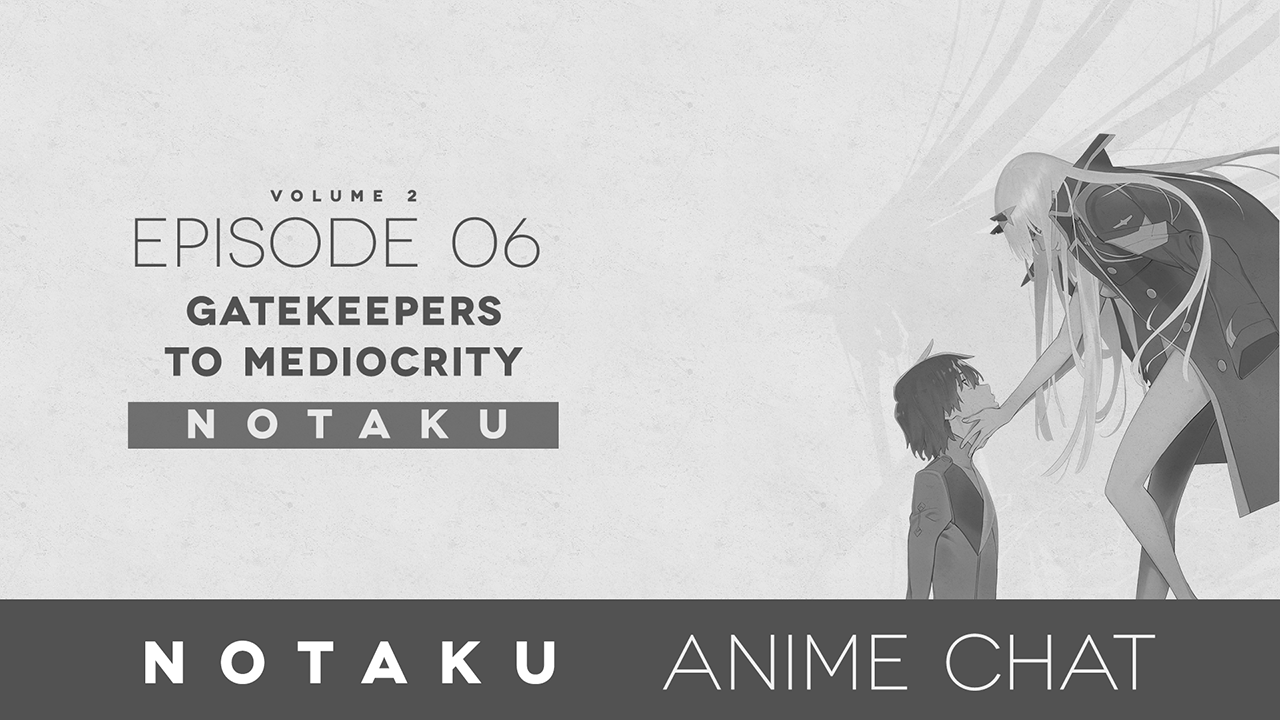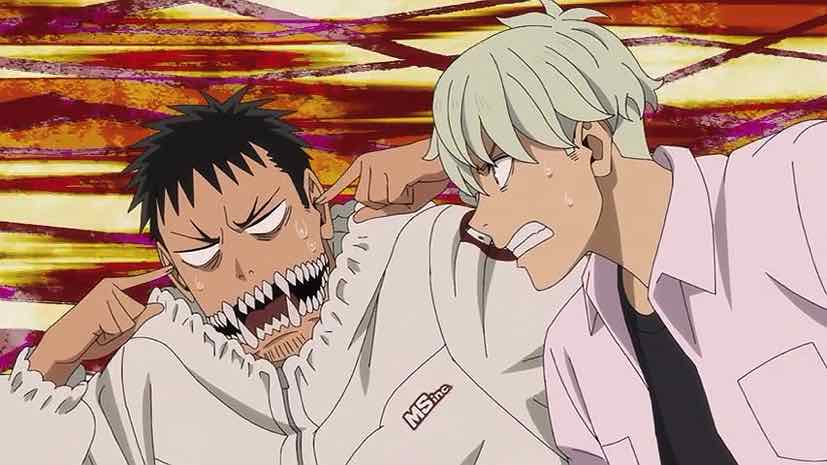Guardian Enzo and Setsuken are back solving (or at least calling out) the problems facing anime. This time we talk about a few non-anime things we’re watching, and a new feature to our news segment, and discuss whether “gatekeepers” exist in the anime fandom (and what role they play). Plus a manga recommendation, a little off-the-cuff-poetry, and a question about series we loved in spite of the visuals.
Please make sure and join us next week for our very special Fall Season Preview episode! If you have anything you’d like us to answer or discuss related to the fall season, please let us know.
Timecodes:
Introduction 0:09
Kimchi 3:50
What We’re Watching 5:21
The Anime News 13:31
Topic of the Week (Are Mediocrity Pushers Anime’s New Gatekeepers?) 49:32
Manga Recommendation Corner (Flat by Aogiri Natsu) 1:29:11
Enzo’s Haiku Challenge (new) 1:34:57
Listener Questions 1:37:25
Sign-off 1:43:48





Princess Usagi
September 16, 2020 at 7:15 amThank you so much for these podcasts-you guys always have such engaging conversations! I am new to manga and not familiar with all the works out there, so I love your manga recommendations! (I’ve started reading Bokuro no Kokoro no Yabai Yatsu and Yokohama Kaidashi Kikou and they are both really interesting)
I was wondering if you know how it is decided what the English titles of anime should be? I’ve noticed that sometimes the English title is very different from what the Japanese title actually says. For example, the upcoming anime, Tonikaku Cawaii has the English title “Fly Me to the Moon”, which is nothing like what the Japanese title means (which has nothing about moons, Evangelion, or Frank Sinatra in it).
Guardian Enzo
September 16, 2020 at 8:34 amYou’re very welcome! The manga recommendations are an especially fun element for me.
Sorry to tease, but we’ll address that during the listener questions segment on the podcast, so stay tuned.
Princess Usagi
September 16, 2020 at 10:27 amCool I can’t wait to hear it! (In hindsight, it probably would have been better to listen to the podcast before asking a question, but I was afraid I would forget what I wanted to ask by the end)
Guardian Enzo
September 16, 2020 at 10:46 amDon’t worry, I meant the next one we record – I’ll ask your question on the air.
Riv
September 16, 2020 at 12:30 pmThanks for another great podcast! I’m glad Yona of the Dawn got a shoutout. I picked up the manga after watching the series and am loving the direction it is going, especially how the mangaka chose to handle Soo-Won and his actions. A question– I enjoy anime series set in past eras of Japan, but the majority I’ve encountered have had a samurai theme. So I’m curious as to what you think are the most neglected periods in Japanese history that you would like to see more anime set in. Also, would you have some recommendations for anime and/or manga that are set in periods of Japanese history that we don’t see showcased as much?
Guardian Enzo
September 16, 2020 at 1:21 pmThanks much. I’ll add that to the list of questions for the show (Angolmois sort of springs to mind for starters).
Yona is one great manga, to be sure. Soo Won is possibly the most fascinating character in the cast – I adore Yoon, but he just hasn’t gotten as much development (which is basically my only complaint with the series, really).
Red
September 16, 2020 at 4:01 pmI can’t help but smile and nod along as I listen to your discussions especially on the topic of the week about gatekeepers as well as adding movies/tv series discussions in the mix, great podcast as always. In the series/franchise that sells the most where kimetsu no yaiba was at the top, was that comicworks/comicwalk? I can’t make out the word clearly and I’m surprised I didn’t hear one piece there. Setsuken need not apologize, the previous podcast (podcast#5) was just as great to listen to overall.
Listener question: What do you think is the series that influence you the most to have a more discerning eye in watching/critiquing anime/manga?
Guardian Enzo
September 16, 2020 at 8:03 pmThat was Oricon.
If possible we’ll answer your question on the next podcast!
Yann
September 17, 2020 at 6:17 amRe. Kimchi: Ball Mason jar (pro tip: “wide mouth” kind is way better in every way) wrapped into an airtight plastic (supermarket type plastic with top spun tight, not a ziplock).
It works. My GF is Korean, so I HAD to figure something out… 😉
Guardian Enzo
September 17, 2020 at 7:20 amMuch appreciated!
Elia Notari
September 17, 2020 at 11:58 pmI can kinda confirm that Shojo mangas are well known in Italy, but that’s due to the fact that shojo anime exploded here in the 80’s and 90’s therefore they led the whole market for a while
Guardian Enzo
September 18, 2020 at 7:29 amThat was kind of my memory of it too. It seemed like while France is undeniably manga’s biggest historical export market (because it’s the only western country that has an almost manga-scale comics culture), Italy was where shoujo kind of exploded.
Blastrix
September 19, 2020 at 1:03 amThis is my first comment on this site in like 9 years or so 😀 I just wanted to chime in on your discussion about gatekeeping.
I have a hard time watching many modern anime today. Some of it is because I’m nearing 30 with different tastes than the ones I had when i watched anime in my teenage years. I still like a bunch of the old anime shows however and sometimes a new one comes along.
I find your commentary on this to be pretty interesting. My taste in anime is both similar and different from yours Guardian Enzo. But we share the same opinion on the state of anime. Namely the lack of diversity.
I’m not so convinced that there is a bubble to burst here however. I’m not well versed in the demographics of anime in general, but I would think they tend to skew younger. It seems like the anime industry still has the ability to attract an audience, but they lose that audience as they grow older. A young demographic tend to produce a narrower set of fiction. You see that when looking at YA novels or CW shows which produce to those markets. But the anime demographic seem to be even narrower, focusing on socially introverted young people. I have nothing to back up this statement, besides the fact that there seem to be so much wish-fulfillment for otaku culture in anime today, and that is what gets popular.
Western television has never been better, and I would argue that movies are not in so bad a state in terms of diversity as you make it sound. Even though the best selling movies tend to be mediocre there is a pretty diverse demographic that watches movies and movies reflect that.
That’s my 2 cents on the topic.
Guardian Enzo
September 19, 2020 at 8:44 amWow – that’s a long hiatus! Thanks for chiming in. We’ll see about the bubble – I would say there are already signs it’s starting to burst. Basically anime is an industry that does only two things right now – isekai LN adaptations and cute girls. There are a few exceptions every season but apart from the occasional WSJ mega-title, that’s the industry’s entire commercial pot. They’ve reached a saturation point and cracks are starting to show, but they seem to have lost the ability to do anything else. Therein lies the problem.
Blastrix
September 19, 2020 at 4:20 pmYes we’ll see 😀 Today anime is basically LN adaptions of cute girls and isekai and manga-titles with occasional exceptions, which, as you say, make no money. I honestly dont watch a lot of anime these days, but I still follow the industry out of plain interest. My hesitancy to this idea of a bubble comes mostly from articles on ANN, describing how anime has been growing in revenue during this decade. Much of that increase is from exports like US but also asian countries like South Korea and China. These culturally like minded countries probably fuels the worst tendencies of the japanese market.
Now I will give you this. I’m well aware that much of this revenue increase doesnt go to the animation studios and the wages and working conditions are poor which isnt really a sign a thriving industry. I think the reason for this is that is still an industry that is passionately driven which often tends to lower wages. Similarly to workers in the games industry.
If I were to take a guess, what is most likely to happen is that troubled studios consolidate to bigger titans with a better bargaining position in the production committee structure. Consolidated studios would still make high budget anime, but middle budget shows would be less if not dissapear. This is what happened in Hollywood. This worsens the problem of diversity, because it is the middle-budget and low-budget shows where risk taking is more viable. The consolidation might be messy which would look like bursting bubble with studios bankrupting, but it could also end up being a somewhat clean proces.
If anything I think the biggest hope for solving the diversity problem at the moment is actually streaming services. I can sympathise that the Netflix release model must hard to blog, but the subscription model has done wonders for TV shows in general. Netflix is more interested keeping you subscribed than having good ratings for advertisement and there is no competition for good timeslots. This has resulted in a very diverse set of series.
And yes the hiatus has been long and probably will be again 😛 I’m enjoying the podcast. Your stance is a rare one in the fandom, but one that is sorely needed 😀
Guardian Enzo
September 19, 2020 at 4:40 pmWell, as we talked about on the ‘cast I (though not Setsuken) am of the opinion that American TV is in great shape, and the varied means of production are the reason. So in theory Netflix and others like them should be good for anime, too. And indeed if you look at what shows up as a Netflix-produced anime, it’s definitely not dominated by CGTCT and isekai series. I would argue that before Great Pretender they haven’t tended to be very good shows, but at least they’re different.
Now, as to the Netflix money not getting to the studios, that’s a function of the same terrible system which is starving anime creatively. Get rid of that somehow and things can improve on so many levels.
Steve
September 21, 2020 at 3:51 pmEnzo: Off topic, but have you seen the kabuki production of Nausicaa?
Guardian Enzo
September 21, 2020 at 6:56 pmNope. Didn’t even realize there was one, TBH.
Steve
September 22, 2020 at 4:34 amThe trailer is on YouTube. Streaming on Mirail for a fee until 09/25/20, but not available in the US. The four hour production is based on the manga. From only the short trailer, I think some of the stage design is quite nice.
https://www.youtube.com/watch?time_continue=3&v=g5lLbDpns-8&feature=emb_logo
Guardian Enzo
September 22, 2020 at 9:14 amYeah, that does look nice. Four hours, though… Kabuki is interesting but there’s not enough espresso in the world.